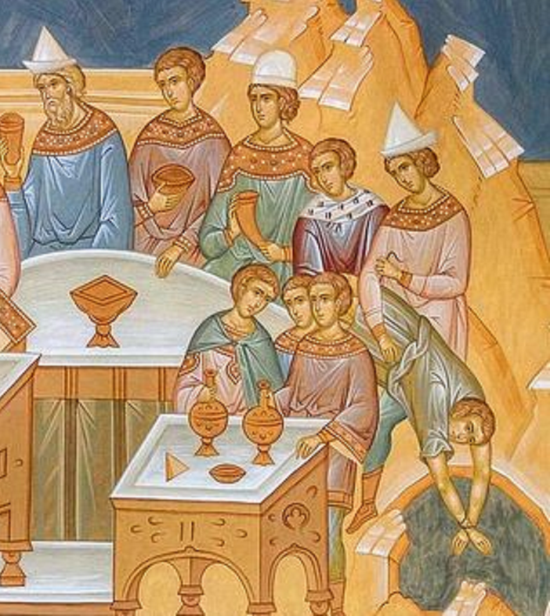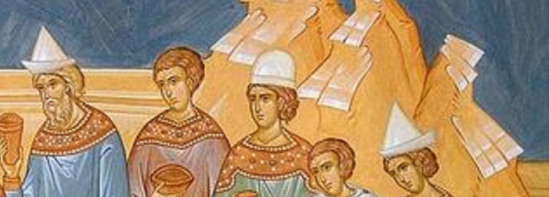Our Place at the Table
Twenty-Eighth Sunday Scripture Readings

Not everything in our Christian Scriptures is clear and easy to understand. Each of the four evangelists composed his gospel from various sources—personal experiences, eyewitness accounts, some already-existing source materials like a now-lost document containing the sayings of Jesus, and even the other evangelists. Today’s gospel passage, for example, occurs only here and in Saint Luke [14:16-24]. Comparing the two, it seems that Luke’s version is earlier. Matthew either took Luke’s version as the basis of his writing or expanded on a source common to both. Either way, because Matthew is attempting to reflect the tensions between the early Christians and the people of Israel, the result is somewhat awkward and unclear.
In Luke’s version, Jesus presents this parable to his fellow guests at a banquet. In effect, he’s seen to be instructing the people of Israel. In today’s passage from Saint Matthew, however, Jesus addresses his comments once again to the leaders of the Jewish people, the chief priests and elders. The setting of the parable is a banquet. Jesus often uses this setting as an image of the reign of God. Matthew modifies Luke’s version in two ways. First, Matthew’s banquet is a wedding feast, and second, his host of the feast is a king. As we shall see, both changes have an impact on the story as Matthew tells it. The concept of a banquet carries more weight than we’re used to ascribing to it. We think of a wedding reception as just a party. That’s our focus. In Jesus’s time, sharing a meal had a deeper, spiritual significance. Eating together meant sharing one another’s life. That’s why it was so scandalous that Jesus ate with so-called “sinners.” Therefore, the banquet or wedding feast was seen as the expression of a common life—in this case, a life in the reign of God.
For Jesus, sharing a life in the reign of God takes place in two dimensions: a life here in this world, and a parallel life hereafter, both presided over by the living God. We refer to the life hereafter by the term “eschaton,” meaning the culmination of life and all things. The eschatological banquet is, in other words, heaven—the eschaton—breaking into the present. Therefore, the banquets in Jesus’s parables are prophetic images. They’re open images. They’re images of the community of God’s people where and when Jesus was preaching, also, the history of the Christian Church, from that moment until the present, and, finally, our communion with God both now and when we have passed from this life. All that is wrapped up in the figure of the banquet.
How did Matthew understand this eschatological banquet that Jesus was talking about? Both Luke and Matthew talk about the host of the banquet. The host issues invitations to his chosen guests. This is a thinly-veiled allusion to the chosen people of Israel whom God has courted throughout their history. Again, and again, the invited decline the invitations up to the point where the preparations for the banquet are complete and the eschatological Day of Yahweh is at hand. Matthew adds to Luke’s version the idea that the invited guests abuse and kill the king’s servants. Once again, it’s an allusion to the persecution of the Christians by the leaders and the people of Israel.
Next, Matthew adds that the king sends his armies to “destroy those murderers and burn their city.” That’s why Matthew’s banquet host is a king. Only a king can command armies. It’s probable that Matthew added this war to his narration to refer to the destruction of Jerusalem by the Romans in 70 AD. Matthew sees the fall of Jerusalem and the destruction of the nation of Israel as the consequence of their rejection of Jesus and his followers.
In both Luke’s and Matthew’s versions of the parable, bringing the uninvited masses into the banquet is certainly an allusion to the Gentiles—the nations—who are now welcomed to the table and who come pouring into the reign of God. Whereas Luke emphasizes how the nations are being pulled into the reign of God, almost by force, Matthew points out the diversity of those called to the banquet—“bad and good alike.” Obedience to the Law is no longer a requirement for admission into the eschatological banquet—the reign of God. All are welcome.
Matthew adds one final feature not found in Luke’s version: the man without a wedding garment. That’s the reason why Matthew makes the banquet a wedding: the white wedding garment is a requirement for attendance. The rejection of the man without the wedding garment is a warning directed toward the Gentile Christians. Just because obedience to the Law is no longer a requirement for entry into the Christian Church—the eschatological reign of God—those who have come in must not take their membership in the community of believers for granted. Christians must be mindful of what they’re about. While good behavior may not be a prerequisite for entry into the reign of God, metanoia—that fundamental change of mind and heart—is. One cannot belong to the reign of God in acceptance, surrender, and gratitude, and yet continue to allow oneself to remain under the tyranny of the ego—self-will run riot.
One of the important features of the baptismal ceremony that takes place immediately after the catechumen descends with Christ into the tomb of baptismal waters and rises from them into the new life of the Holy Spirit is the clothing in a white garment. There’s no question that the wedding garment in Matthew’s version of the parable is a reference to this baptismal garment and the metanoia it symbolizes. That’s the background to today’s parable.
What happens when we bring this parable into our daily lives? Time and time again, Jesus’s parables call us out of slavish legalism and into the realm of selfless love. Lest there be any doubt about the nature and essence of true Christianity, the parables of the Kingdom are unambiguous: the reign of God cannot be reached by following laws. Only the cross of Christ stands as the doorway to it. The cross is more than simply a reminder of what happened to Jesus. It’s more than a symbol of our redemption. It’s a summons to each one of us to “Come, follow me,” and do what I have done. Nowhere do the gospels say, “Greater love has no one than to follow the Ten Commandments.” No. Jesus says, “Greater love has no one than to give up their lives for another.” The cross of Jesus is a constant invitation to us to accept the metanoia—the change of mind and heart—and so enter the eschatological banquet that is the reign of God.
Sometimes, we may think that our baptism was a one-and-done thing. After all, Saint Paul writes, “Or are you unaware that we who were baptized into Christ Jesus were baptized into his death? We were indeed buried with him through baptism into death, so that, just as Christ was raised from the dead by the glory of the Father, we too might live in newness of life.” [Romans 6:3-4] Didn’t we then put on our wedding garment, and take our place at the table? Yes, we did…however, that wedding garment, that symbol of our metanoia lasts only until our next decision. Countless times during the day, we’re faced with the choice: do I respond with self-effacing love, or do I just serve myself? Each time, we either renew our baptismal commitment to follow Christ and his cross, or we approach the table of the Kingdom without the wedding garment of a changed heart. Salvation, that is, inclusion in the reign of God, isn’t just any one moment in time, it’s a process—a constant stream of small choices to accept the invitations from the King as they come, to remain faithful to the cross of Christ, and to maintain our place at the banquet table of our God…or not. May we always choose well.
Get articles from H. Les Brown delivered to your email inbox.
